
Graduated from the Secretary Dept, Henan Institute of Finance and Economics, with a BA's degree. Holding an academic title of Museologist, she is dedicated to administration of books and journals, study on museology as well.

Graduated from the History School of Zhengzhou University with a master's degree, currently serves at the Exhibition Dept. of Henan Museum
The arm-folding female figurine has her hair worn in a bun high on the crown and applies rouge on her lips. Inside the wide-sleeved button-down gown there is a fine pleated long skirt. She wears a pair of cloud-toed shoes and folds her hands in the wide sleeves. The figurine stands on a square base. The seal-holding female figurine has her hair worn in two ring-shaped buns. The red string drapes over her ears. Over her fine pleated long skirt is an open-necked gown with wide sleeves. Her shoes are completed covered by the skirt, except the cloud-shaped toes. A silk ribbon goes around her waist and drapes down at the back. The female figurine holds a seal wrapped in a piece of red cloth and stands on a square base. Both females have delicate features, looking mild and reserved in their faces, as if they are in readiness for any new work to do.
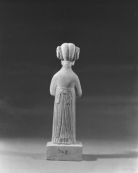
Fig.1: Back of the seal-holding female figurine
Both figurines are carved from limestone in concise yet smooth line engraving and circular engravure with delicate craftsmanship. The line-engraved hair buns and skirt pleats are particularly fine. The texture of clothes is well represented in a real sense. Originally coated with paints, both figurines are now almost colourless, except the red paint remnant on the bodies. The stone female figurines then look true to life, yet in an artistic way. However, the figurines have their heads out of proportion and “there are on them traces of a portrait sculptor style of the Sui and Tang dynasties, overstressing the facial features”.
Both figurines are of the typical Song style in shape and craftsmanship. These two masterpieces of the Song Dynasty stone carvings in the round well demonstrate the artisans’ superb creativity and craftsmanship in representing the real life in art, thus are of high values for the study of stone carving art of the Song Dynasty.
Old families of powerful and influential officials declined in the turbulence during the late Tang Dynasty and Five Dynasties. The boundary between officialdom and commoners was removed. After the Northern Song court had reunited China, agriculture, handicraft and commerce got fast developed and thrived. Urban economies flourished. Bourgeois rose as an emerging power and become a new voice in aesthetics and art. Accordingly, bourgeois culture emerged. The Song Dynasty saw the reorganization and integration of cultures of the previously separatist groups and regimes and witnessed a critical change in aesthetics in feudal China. Previously magnificent, open and grand, Chinese culture during the Song Dynasty on the whole became reserved, realistic and elegant, and stressed more the beauty of humanity. The painting, literature, sculpture and many other art activities of the Song Dynasty experienced changes, as the overall cultural ethos changed.
Sculptures of the Song Dynasty tended to portray “humans”, instead of deities, and represent people’s daily life in the world of art. The Song sculptures are typically put into three categories, namely tomb carvings, religious statues and desk sculptures. The essay focuses more on the tomb carvings that are further divided into two groups, namely those for imperial mausoleums and those for ordinary tombs. The carvings for the imperial mausoleums of the Northern Song Dynasty are the masterpieces of the kind and basically follow the style of those of the Tang Dynasty. That is, stone human and animal carvings are arranged into groups, smaller in size compared with that in the Tang Dynasty, though. The stone carvings for the Northern Song mausoleums are neatly arranged and the animal carvings look true to life.
The sculptures in an ordinary tomb of the Song Dynasty are usually burial figurines, varying in shape and design and revealing the life back then. Figurines are the burial replacements for human sacrifices and reflect the funerary customs and rites in ancient China. As funerary customs experienced changes in the Song Dynasty, the burial figurines saw a sharp decline and were inferior to those in the previous times both in quality and quantity. However, the burial figurines of the Song Dynasty are of distinguishable features: (I) New creations emerged, representing people’s daily life, such as figurines of group performers, the Four Deities, scholars and sedan-chair carriers. (II) New crafts emerged. Brick figurines were created during this time. In addition to carvings in the round, many other crafts were applied, including sculpting, carving, moulding, painting and stamping. Moreover, a figurine got better proportionate. Facial features were better represented and the social status of figurines well discriminated. (III) Stone figurines emerged during the Song and Liao dynasties, including those made of bluestone and agalmatolite. Nonetheless, ceramic figurines were of the largest number at the time, much more than figurines made of wood, stone and other materials. By area, there were more porcelanous figurines in the south of the Song Dynasty, while terracotta, brick and wall figurines were largely found in the north.
Quite a number of burial figurines have been unearthed from the tombs of the Song Dynasty, even though burial figurines were on decline during the period. It is particularly noteworthy that a great number of stone figurines have been discovered in the tombs of the time, such as Family Fan’s tombs in the Fangcheng County of Henan Province and tombs of Chen Yuanji and Xu Jun in Fujian Province. As the archaeological discoveries shows, all the burial figurines unearthed from the Song tombs in Henan Province have been terracotta or brick figurines, except those excavated from Family Fan’s tombs in the Fangcheng County of Henan Province. Meanwhile, stone figurines have been discovered in large numbers in the Song tombs in southern areas, particularly in Fujian.
The Song tombs in Henan saw much smaller a number of stone figurines than those in Fujian did. The figurines discovered in the two tombs in Henan are carved out of limestone, while those in Fujian agalmatolite.
In terms of the shape, the burial figurines fall into two categories, human and animal, and most of them are human’s shape in the Song tombs. Those lifelike figurines portray figures from all walks of society at the time, including menservants/maidservants, civil officials, military officers and even immortals and religious figures, and servant and official figurines are dominant ones. The burial figurines not only reveal the tomb occupant’s life when he/she was alive, but also reflect the power and honor he/she used to enjoy. Tomb-guarding and deity figurines were placed in a tomb to safeguard the tomb occupant’s peace in the netherworld and closely related to religious beliefs and geomantic factors.
Animal figurines are in comparatively a small number, compared with human figurines. Mostly in shape of commonly-seen animals, such as chicken, ducks, dogs, horses and tortoises, those animal figurines are placed in a tomb as the symbol of a prosperous life. Figurines of mythical animals depict something not existing in real life, as a symbol of auspiciousness and happiness.
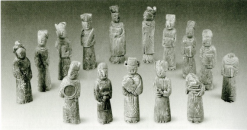
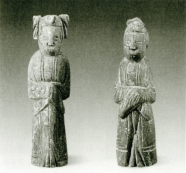
Fig.2 Stone article-holding figurines unearthed from the southern chamber of Chen Yuanji’s tomb, Fujian Province
Fig.3 Stone arm-crossing figurines unearthed from the southern chamber of Chen Yuanji’s tomb, Fujian Province
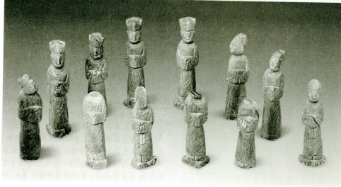
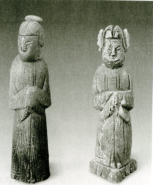
Fig.4 Stone arm-folding figurines unearthed from the northern chamber of Chen Yuanji’s tomb, Fujian Province
Fig.5 Stone arm-crossing figurines unearthed from the northern chamber of Chen Yuanji’s tomb, Fujian Province
(Source of Figures 2-5: Cultural Relics, Vol. 7, 2011)
The stone figurines unearthed from Family Fan’s tombs in the Fangcheng County are of more delicate craftsmanship. Coated with coloured paints, those stone figurines have delicate features. Their clothes and hair are lifelike and well demonstrate the figurines’ characteristics. The agalmatolite figurines discovered in Fujian, on the other hand, are of relatively simple craftsmanship. Carved largely into 3D in the round, those figurines look a bit blurred in facial features. However, the human and animal figurines have a beauty of simplicity, as parallel curves in intaglio or diamonds and checkers are applied to portray their clothes and scales.
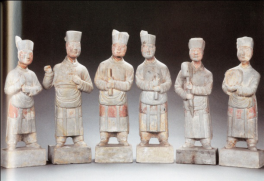
Fig.6 Stone figurines of male servants unearthed from Fan Tongzhi’s tomb (Source: Ancient Civilization of the Central Plains)
As the epitaph shows, Fan Tongzhi and his wife from a Qiang family were both from Gaoping of Jian’an Prefecture, that is, present-day Jian’ou County of Fujian Province. The couple was interred somewhen during the reigns of Emperor Zhezong and Emperor Huizong of the late Northern Song Dynasty. Agalmatolite sculpture of Fujian boasts a long history. The earliest piece dated back to the Southern Dynasties. A tomb of the Southern Dynasties was discovered in 1954 in Cangshan, Fujian Province. From this tomb was unearthed an agalmatolite pig figurine, indicating that agalmatolite carvings were already created in Fujian 1,500 years ago. People in Fujian began to use agalmatolite burial figurines in the Northern Song Dynasty. This practice was at the rage during the Southern Song Dynasty. Family Fan had the ancestral home in Fujian. Fan Zhixu, the third son of Fan Tongzhi and his wife worked twice as governor of Dengzhou Prefecture. The family then moved to the Fangcheng County and most of the family members died there. Their remains weren’t sent back to their hometown. However, they never abandoned the old funerary traditions and placed stone figurines in a tomb. Nonetheless, it was unable to get Fujian-produced agalmatolite for those figurines. Therefore, Family Fan adopted the locally-produced limestone as a replacement. Moreover, the stone figurines feature local craftsmanship as well.
We may guess what a figurine did through its clothes and looks. For example, the seal-holding female may be a maid-servant in charge of her host’s seal. What may the arm-folding female do?
Your answer please, if you have any questions or answer, please feel free to send us email, we are waiting for your answers and participation, and your comments, answers and suggestions will be highly appreciated. We will select and publicize the most appropriate answers and comments some time in the future.
Weekly Selection Email: meizhouyipin@chnmus.net
Attire and Hair Style of Females of the Song Dynasty
Artisans in ancient China made figurines according to the social conditions and human features. Figurines then reveal the lifestyle and attire of different historical periods. The two stone female figurines unearthed from Fan Tongzhi’s tomb of the Northern Song Dynasty well show the attire and hair style of females of the time.
The arm-folding female figurine features curved brows and red lips. Her black hair is worn into a bun high on the crown. Females back then preferred to do their hair in various styles and apply pins of gold, pearls and gems onto the hair buns. It was quite popular with women in the Song Dynasty. A hair bun high on the crown actually emerged in the Five Dynasties. The bun got even higher and larger in the Song Dynasty. The hair style became more popular in the late Northern Song Dynasty with women, be they nobles or commoners. To get a more impressive effect, some even wear artificial hair buns.
Either female figurine has on a narrow-sleeved button-down gown inside a red gown with wide sleeves. She wears a fine pleated long skirt around her waist. The lines on clothes are clear and airy-looking. The tip toes of her shoes look like a phoenix’s beak and are slightly seen under her skirt. The figurines demonstrate the basic attire a woman had in the Song Dynasty. The wide-sleeved red gown was known as beizi in the Song Dynasty. First seen during the Sui and Tang dynasties, the design was developed from banbi (a short-sleeved gown) and in vogue during the Song and Yuan dynasties. Women of the Song Dynasty, regardless of their social status, wore beizi as informal or formal suits. Basically a long-sleeved button-down gown, a beizi has wide or narrow sleeves and is of knee-length, or above knee or of ankle-length. There are openings below underarms and ribbons draping down from underarms and at the back. The front and back pieces are not sewn up or laced with loop buttons. A beizi was usually worn over an unlined upper garment, a short jacket or a skirt and added a touch of elegance to a woman.
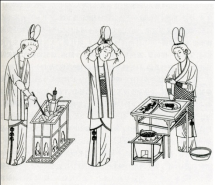
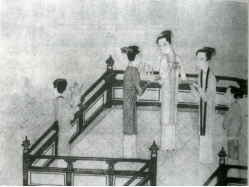
Fig.7 Brick carvings of kitchen maids, Song Dynasty
Fig.8 Women in beizi illustrated in Women Enjoying the Moon of the Song Dynasty
(Source: A Study of Ancient Chinese Costumes)

Fig.9 A maidservant statue (wearing a beizi) in the Hall of the Holy Mother in the Jinci Temple, Shanxi Province (Source: Series of Selected Chinese Painted Sculptures)
The seal-holding female wears a jewel-necked garment inside a narrow-sleeved short jacket and has a fine pleated skirt around her waist. Her hair is done into two ring-shaped buns. A young girl of the Song Dynasty usually dressed herself up this way. The hair style was originally two simple buns. An unmarried female would look more attractive with such a hair style. Also, the hair style was commonly seen among young maidservants and became one worn by young females of lower social status.

Fig.10 A maidservant statue with her hair done in two buns in the Hall of the Holy Mother in the Jinci Temple, Shanxi Province (Source: Series of Selected Chinese Painted Sculptures)
The two figurines unearthed from Fan Tongzhi’s tomb depict two females in different age groups in the Song Dynasty. The arm-folding female in beizi is superior both in age and social status to the seal-holding one.
The 33 colour-painted statues of maidservants in the Hall of the Holy Mother in the Jinci Temple in Taiyuan, Shanxi Province are the masterpieces of the Song Dynasty. All of them are the original ones of the Song Dynasty. Those true-to-life statues were made to the imperial concubines or noble women of the time, all with delicate features. The Jinci Temple was built as a sacrificial place for deities. The statues were thus made to some extent in a bit exaggerated way in their costumes and colours. Some of the costumes were not in daily use any more in the Song Dynasty. Therefore, the statues in the Jinci Temple cannot show the common features of the Song-style costumes. The figurines unearthed from Fan Tongzhi’s tomb, however, are burial objects for an ordinary official of the Song Dynasty. Their clothes are simple yet elegant-looking in style and true to life. The two figurines provide us with precious object materials to learn more about women’s clothes of the Song Dynasty.
